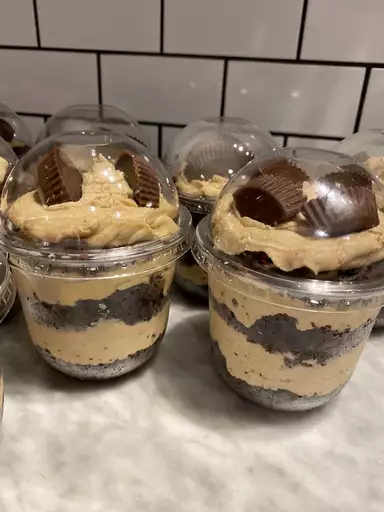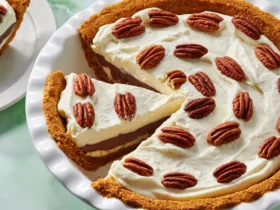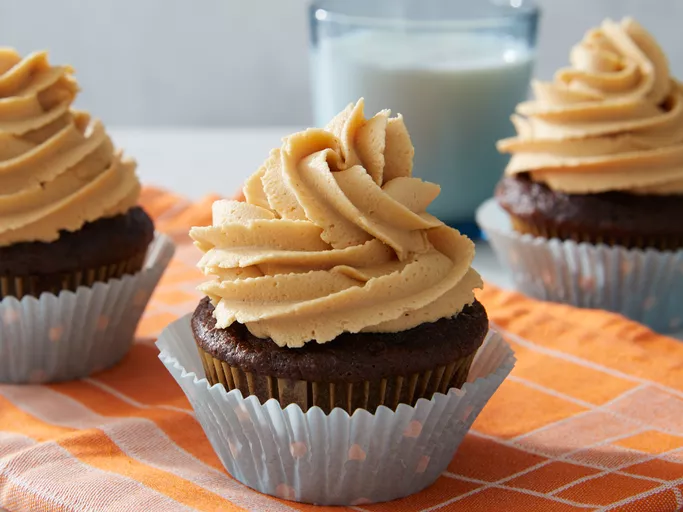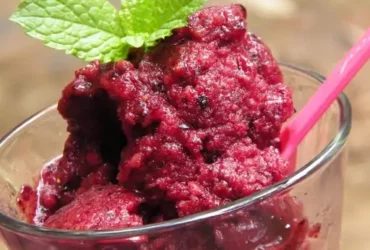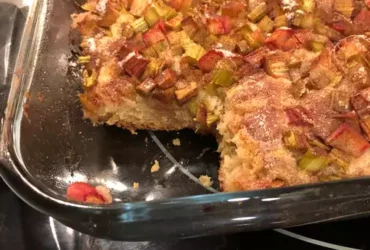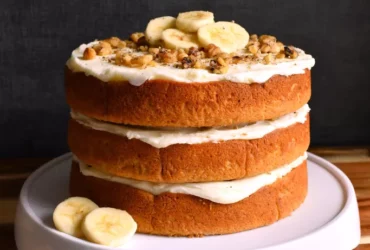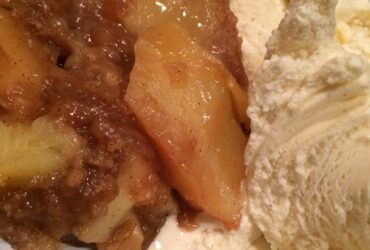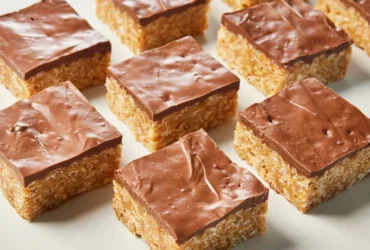Ingredients
Butter and Oil
The key to achieving a fluffy peanut butter frosting lies not only in the right ratio of peanut butter to powdered sugar, but also in the type and quantity of ingredients used.
In terms of fat content, both butter and oil can be used to enhance the flavor and texture of the frosting. However, using high-quality ingredients is crucial for achieving a smooth and creamy consistency.
Peanut butter itself serves as the primary source of protein and fat in the frosting, but adding some type of oil or butter can help to create a lighter and more spreadable texture.
European-style unsalted butter, with its higher water content and richer flavor profile compared to regular American butter, is an excellent choice for this recipe. Melted butter adds moisture and tenderness while enriching the peanut butter flavor with notes of sweetness and depth.
Neutral oils like canola or grapeseed work well in conjunction with melted butter to balance out the richness of the peanut butter and powdered sugar. These oils also add a hint of subtle nuttiness without overpowering the other ingredients.
The ratio of oil to peanut butter is typically 1:4, but this may be adjusted depending on personal preference for consistency and flavor profile.
For an extra light and airy frosting, try incorporating some shortening or cream cheese into the mixture. The added fat content helps to create a silky and pliable texture that’s perfect for spreading on cupcakes or cakes.
When selecting peanut butter for this recipe, choose natural peanut butters with minimal added sugars and oils, which will allow the natural flavors of the peanuts to shine through in the finished frosting.
1 cup unsalted butter, at room temperature
The first ingredient required for this delectable Fluffy Peanut Butter Frosting Recipe is 1 cup of unsalted butter. This fundamental component plays a pivotal role in not only adding flavor but also lending a rich texture to the frosting.
It’s essential that the butter be at room temperature, which typically falls between 68°F and 72°F (20°C and 22°C). This allows for easier mixing and incorporation of air, crucial factors in achieving the fluffy consistency we’re aiming for in this peanut butter frosting.
The unsalted variety of butter is chosen for its mild flavor, which won’t compete with the peanut butter’s distinct taste but rather complement it harmoniously. Unsalted butter also ensures that our frosting doesn’t become overly salty, maintaining a balance that’s perfect for those seeking to pair it with various treats.
When selecting the butter, it’s vital to consider its quality and freshness. Opting for high-quality unsalted butter will guarantee the best results in your Fluffy Peanut Butter Frosting. Freshness is equally important as stale or old butter may not yield the desired light, airy texture we’re after.
2 tablespoons vegetable oil
Vegetable oil is an essential ingredient in this Fluffy Peanut Butter Frosting Recipe, serving as a crucial component that contributes to the smooth and creamy texture of the frosting.
In order to obtain 2 tablespoons of vegetable oil, you can use any neutral-tasting oil with a high smoke point. Some examples include canola oil, grapeseed oil, or sunflower oil.
The purpose of using vegetable oil in this recipe is not only for its lubricating properties but also for helping to balance out the richness and nuttiness imparted by the peanut butter.
When measuring out 2 tablespoons of vegetable oil, make sure to use a digital kitchen scale or a standard measuring spoon to ensure accuracy. This will guarantee that you have the perfect amount of oil to achieve the desired consistency in your frosting.
In addition to being a crucial component of this Fluffy Peanut Butter Frosting Recipe, vegetable oil is also an excellent choice for baking due to its mild flavor and versatility.
When substituting vegetable oil with other oils, keep in mind that different oils have unique flavors and characteristics. For instance, olive oil has a distinct fruity taste, while coconut oil adds a hint of coconut flavor. In this recipe, a neutral-tasting oil is preferred to avoid overpowering the peanut butter’s flavor.
Instructions and Techniques
Making the Frosting
To make the frosting for our Fluffy Peanut Butter Frosting Recipe, we will first focus on understanding the key instructions and techniques involved in its preparation.
The process begins with ensuring that all the ingredients are at room temperature, including the peanut butter, cream cheese, and butter. This is crucial as it affects the overall consistency and texture of the frosting.
Next, we will need to sift together the powdered sugar and a pinch of salt in a medium-sized bowl. Sifting helps to remove any lumps and ensures that the powdered sugar is evenly distributed, which is essential for achieving a smooth frosting.
In another large mixing bowl, we will cream together the peanut butter and butter until light and fluffy. This process can be achieved using an electric mixer or a manual whisk, depending on personal preference and available equipment.
Once the peanut butter mixture has reached the desired consistency, we will add in the sifted powdered sugar and salt mixture to the bowl and mix until well combined. The addition of the powdered sugar mixture helps to balance out the richness of the peanut butter and provides a smooth texture to the frosting.
Next, we will add in the softened cream cheese and mix until it is fully incorporated into the mixture. The cream cheese helps to add moisture and a tangy flavor to the frosting, which complements the peanut butter perfectly.
We will then beat the mixture on high speed for an additional 2-3 minutes, or until it has reached the desired consistency and texture. This step is crucial as it ensures that the frosting is light, fluffy, and easy to spread.
Finally, we will add in any desired mix-ins such as peanut butter chips, chocolate chips, or chopped nuts, and fold them into the frosting until they are evenly distributed.
The completed frosting can then be stored in an airtight container in the refrigerator for up to 3 days or frozen for up to 2 months. It is essential to let the frosting come to room temperature before using it, as this helps to achieve the best possible texture and consistency.
Cream together butter and peanut butter until smooth.
In this section, we will delve into the essential instructions and techniques required to create a delicious and fluffy peanut butter frosting, perfect for topping cakes, cupcakes, and other baked goods.
Techniques
- Creaming Butter and Peanut Butter: This process involves beating the butter and peanut butter together until they become smooth and well combined. The key to achieving a fluffy frosting is to ensure that there are no visible streaks of peanut butter or butter in the mixture.
- Aiming for the Right Consistency: The ideal consistency for the peanut butter frosting is smooth, yet still holds its shape when piped onto a surface. If the frosting is too thin, it may be necessary to refrigerate it for a few minutes before attempting to re-whip it.
- It’s essential to add powdered sugar gradually to achieve the perfect balance of sweetness and consistency in your frosting. Adding too much powdered sugar at once can result in a frosting that is overly sweet or even grainy.
Step-by-Step Instructions
To ensure success with this recipe, it’s essential to follow each step carefully.
- Step 1: Cream together butter and peanut butter until smooth. Using an electric mixer or a wooden spoon, beat the softened butter and peanut butter together in a large mixing bowl until they become well combined and form a smooth paste.
- Step 2: Add powdered sugar gradually and whip until smooth. Gradually add the powdered sugar to the peanut butter mixture while continuously whipping with an electric mixer or wooden spoon until all of the powdered sugar is fully incorporated, and the frosting reaches the desired consistency.
- Step 3: Add milk or heavy cream as needed. If the frosting becomes too stiff during the process, add a small amount of milk or heavy cream to achieve a smooth and spreadable texture. Be cautious not to over-mix.
By following these instructions and techniques, you’ll be able to create a delicious and fluffy peanut butter frosting perfect for topping your favorite cakes, cupcakes, and other baked goods.
Beat in confectioners’ sugar gradually until well combined.
When it comes to crafting a fluffy peanut butter frosting, mastering the technique of incorporating confectioners’ sugar is crucial. The instruction “Beat in confectioners’ sugar gradually until well combined” serves as a critical step in this process.
To begin with, it’s essential to understand that confectioners’ sugar, also known as powdered sugar, plays a vital role in frosting texture and consistency. When adding it to the peanut butter mixture, you want to achieve an even distribution of sugar particles to avoid creating a grainy or lumpy frosting.
Gradual incorporation is key here. Adding confectioners’ sugar too quickly can result in a frosting that’s overly sweet and potentially too thick, while doing so slowly allows for better control over the final consistency.
The term “well combined” suggests that you should continue beating until the confectioners’ sugar has fully incorporated into the peanut butter mixture. This may take several minutes, depending on your mixer’s speed and power.
When determining if the sugar has been sufficiently incorporated, look for signs such as a smooth, even texture and a lack of visible sugar particles or streaks within the frosting.
The process can be compared to kneading dough: just as overworking dough can result in tough bread, over-beating your peanut butter frosting can lead to a dense, unworkable consistency. Therefore, it’s essential to find that sweet spot where everything comes together seamlessly.
For optimal results, make sure to use room-temperature ingredients and maintain your mixer at its recommended speed during the incorporation process. If using an electric mixer, start with low speeds and gradually increase as needed to avoid creating a mess or overworking the mixture.
Semisweet Chocolate Variation
The art of crafting the perfect Fluffy Peanut Butter Frosting begins with understanding the nuances of chocolate and its various forms. In this section, we will delve into the world of semisweet chocolate variation, exploring the techniques and instructions necessary to elevate your baking game.
When it comes to semisweet chocolate, the key is to strike a balance between bitterness and sweetness. A good quality semisweet chocolate should have a rich, deep flavor profile that complements the nuttiness of peanut butter. However, for those who prefer a milder taste, we will also explore how to create a sweeter variation by incorporating other types of chocolate.
Here are the essential instructions and techniques for crafting the perfect semisweet chocolate variation:
Technique 1: Chocolate Melt
To begin, you’ll need to melt your chosen chocolate using one of two methods: the double boiler or the microwave. For a more precise control over temperature, we recommend the double boiler method.
Double Boiler Method
Place a heatproof bowl over a pot of simmering water, ensuring that the bottom of the bowl is not touching the water. Break up the chocolate and place it in the bowl, stirring occasionally until fully melted.
Microwave Method
In 30-second increments, microwave the chocolate in 10-15 second intervals, stirring between each interval until smooth.
Technique 2: Chocolate Tempering
Once your chocolate is melted, it’s essential to temper it. This process involves cooling and re-heating the chocolate to create a stable crystal structure that will give your final product a glossy appearance and satisfying texture.
To temper your chocolate:
- Step 1: Cool the Chocolate: Allow the melted chocolate to cool to around 82°F (28°C), or until it reaches the ideal cooling temperature for your specific type of chocolate.
- Step 2: Reheat the Chocolate: Gently re-heat the cooled chocolate to its working temperature, typically between 88°F and 90°F (31°C and 32°C). This will help to create a stable crystal structure that is ideal for dipping or drizzling.
Technique 3: Emulsifying Peanut Butter Frosting
To create the fluffy peanut butter frosting, it’s essential to properly emulsify the peanut butter and chocolate mixture. This can be achieved by slowly incorporating air into the mixture while gently folding it with a rubber spatula.
As you cream together your peanut butter and sugar, make sure to scrape down the sides of the bowl regularly to ensure that all ingredients are fully incorporated.
Final Tips
To create an even fluffier frosting, make sure to add a pinch of salt to balance out the sweetness of the peanut butter and chocolate. Additionally, for a more intense flavor, you can add a teaspoon or two of vanilla extract to your mixture.
With these instructions and techniques in hand, you’ll be well on your way to creating the perfect Fluffy Peanut Butter Frosting using semisweet chocolate variation!
Melt 1 cup semisweet chocolate chips in a double boiler over low heat.
To prepare the Fluffy Peanut Butter Frosting, it’s essential to follow specific instructions and techniques that will ensure a smooth and creamy texture. The first step involves melting chocolate chips, which requires attention to detail and control over heat.
For melting 1 cup of semisweet chocolate chips, you’ll need a double boiler set up on low heat. A double boiler is a heatproof bowl placed over a pot of simmering water, allowing for gentle heat distribution without direct exposure to flames. This technique is crucial in preventing the chocolate from seizing or developing an unpleasant flavor.
The process of melting involves carefully placing the chocolate chips into the top bowl and ensuring they’re evenly distributed. Next, you’ll want to adjust the heat to a low setting and monitor the temperature closely. Semisweet chocolate typically melts between 105°F and 115°F (40°C to 46°C), so aim for this range to maintain its flavor and texture.
As you melt the chocolate chips, gently stir the mixture occasionally to prevent scorching or burning. It’s also vital to avoid overheating the chocolate, which can cause it to become grainy or separate from other ingredients in the frosting recipe. Once melted and smooth, remove the bowl from the double boiler and let the chocolate cool slightly.
This melting process is an essential step in preparing the Fluffy Peanut Butter Frosting Recipe, as it sets the stage for incorporating peanut butter, cream cheese, powdered sugar, and vanilla extract. By following these precise instructions and using a double boiler to melt chocolate chips over low heat, you’ll be able to create a rich and creamy frosting that’s perfect for topping cakes or pastries.
Fold melted chocolate into frosting mixture.
To create the perfect fluffy peanut butter frosting, it’s essential to master the art of folding melted chocolate into the frosting mixture. This delicate technique requires a gentle touch and patience to ensure that the final product is smooth, creamy, and utterly delicious.
Folding is an important step in baking, as it helps to combine two or more ingredients while maintaining their individual textures and structures. When working with melted chocolate, it’s crucial to temper it correctly before folding it into the frosting mixture. Tempering involves heating and cooling the chocolate to a specific temperature range, which will determine its stability and texture.
Temper your melted chocolate by placing it in a heat-resistant bowl set over a pot of simmering water. Stir occasionally until the chocolate reaches a temperature between 105°F (40°C) and 115°F (46°C). Remove the bowl from the heat and let it cool slightly, until the chocolate has reached around 82°F (28°C) to 86°F (30°C).
Now that your chocolate is tempered, it’s time to fold it into the frosting mixture. Start by whipping the peanut butter frosting on medium-high speed with a stand mixer or handheld electric mixer until it becomes light and airy. This should take about 2-3 minutes.
Add the cooled melted chocolate to the whipped frosting and reduce the mixer speed to low. Gradually pour the chocolate into the frosting while continuously mixing, being careful not to add too much at once. The goal is to create a smooth, even consistency that’s still light and airy.
Continue folding the chocolate into the frosting for another 2-3 minutes, or until the desired texture is achieved. You may need to stop the mixer periodically and scrape down the sides of the bowl with a rubber spatula to ensure everything gets well incorporated.
When you’re satisfied that your peanut butter frosting has the perfect fluffy consistency, give it one final whip on high speed for about 30 seconds to 1 minute. This will help create a smooth, velvety texture and get rid of any remaining air pockets.
That’s it! With these simple steps and techniques, you’ll be able to create a fluffy peanut butter frosting that’s perfect for topping cakes, cupcakes, or even just using as a snack on its own. Remember to temper your chocolate correctly and fold it into the frosting with patience, and you’ll be rewarded with a deliciously light and creamy treat.
Tips and Variations
Using Different Types of Peanut Butter
In this recipe, we’ll explore tips and variations for using different types of peanut butter to create a delicious Fluffy Peanut Butter Frosting.
When working with peanut butter in frosting recipes, it’s essential to choose the right type to achieve the desired consistency and flavor. Here are some common types of peanut butter you can use:
- Creamy Peanut Butter: This is the most commonly used type of peanut butter for frosting recipes. It has a smooth, creamy texture and a mild nutty flavor.
- Crunchy Peanut Butter: For those who prefer a little crunch in their frosting, crunchy peanut butter is a great option. The added crunch from the peanuts can add texture and interest to your frosting.
- Natural or Old-Fashioned Peanut Butter: This type of peanut butter has a coarser texture and a more pronounced nutty flavor compared to creamy or crunchy peanut butter.
- Organic Peanut Butter: If you’re looking for an organic option, there are many brands available that use high-quality peanuts and minimal processing.
- Reduced-Fat Peanut Butter: For those watching their calorie intake, reduced-fat peanut butter is a good alternative. However, keep in mind it may not have the same creamy texture as regular peanut butter.
Now that you know your options, here are some tips for using different types of peanut butter in your Fluffy Peanut Butter Frosting recipe:
- Mix and match: Feel free to mix and match different types of peanut butter to create a unique flavor profile. For example, you could combine creamy and crunchy peanut butter for a fun texture.
- Add-ins: Consider adding other ingredients like honey, chocolate chips, or chopped nuts to your frosting for added flavor and texture.
- Flavor boosters: Use natural flavorings like vanilla extract or sea salt to enhance the flavor of your peanut butter frosting.
In conclusion, using different types of peanut butter can add variety and excitement to your Fluffy Peanut Butter Frosting recipe. Experiment with different options and find the combination that works best for you!
Natural peanut butter may separate, so beat until smooth before using.
Peanut butter can be quite versatile, and there are several ways to use it in your frosting recipe. Here are some tips and variations to consider:
Natural peanut butter may separate, so beat until smooth before using. This ensures that the peanut butter is well-mixed and has a consistent texture.
You can also use creamy or crunchy peanut butter, depending on your personal preference. Creamy peanut butter will result in a smoother frosting, while crunchy peanut butter adds a nice texture contrast.
For a chocolate-peanut butter combination, add some cocoa powder or melted chocolate to the peanut butter mixture before whipping it into cream. This will give you a rich and decadent flavor profile.
To make a lighter and fluffier frosting, whip the peanut butter mixture until it becomes stiff and doubled in volume. This can take several minutes with an electric mixer or up to 10-15 minutes by hand.
If you’re using natural peanut butter that’s prone to separating, try adding a tablespoon or two of honey or maple syrup to help stabilize the mixture. This will also add a touch of sweetness to your frosting.
For an extra creamy frosting, try adding some heavy cream or half-and-half to the peanut butter mixture before whipping it into cream. This will give you a silky smooth and rich texture.
Remember that when working with peanut butter, it’s essential to use high-quality ingredients and follow proper storage and handling techniques to ensure the best results.
Adding Flavorings or Nuts
To take your fluffy peanut butter frosting to the next level, consider adding unique flavor combinations or textures with nuts and other ingredients.
One way to add an extra boost of flavor is by incorporating extracts such as vanilla or almond into the frosting. Start with a small amount (about 1/4 teaspoon) and adjust to taste. This will complement the peanut butter without overpowering it.
For a more intense nutty flavor, try adding chopped nuts like peanuts, pecans, or hazelnuts directly into the frosting. You can also toast them lightly in a pan for a few minutes to bring out their natural oils and enhance their flavor.
Another option is to add some spice to your frosting with cinnamon, cayenne pepper, or smoked paprika. Use these spices sparingly as they can quickly overpower the peanut butter. A pinch of salt can also help balance out the sweetness of the frosting.
Fruit additions can create a delightful combination in your fluffy peanut butter frosting. Try mixing in some diced strawberries or raspberries for a sweet and fruity twist, or use some cocoa powder to give it a chocolate-peanut butter fusion.
For an extra-creamy texture, you can add some plain Greek yogurt or sour cream into the frosting. This will not only provide a tangy flavor but also help stabilize the frosting’s consistency.
A pinch of sea salt is a great addition to balance out the sweetness in your fluffy peanut butter frosting. It will enhance the flavors and textures without overpowering them.
Finally, you can get creative with the type of sugar used in the recipe. Browned sugar or muscovado sugar add a richer flavor profile compared to regular white sugar, making it an excellent option for those looking to try something different.
Add 1/4 teaspoon salt or 1 tablespoon chopped peanuts to frosting for extra flavor.
- Add a pinch of salt to enhance the flavor of the frosting.
- The addition of 1/4 teaspoon of salt can elevate the taste of the frosting and balance out the sweetness of the peanut butter.
- For an added crunch, sprinkle 1 tablespoon of finely chopped peanuts on top of the frosting.
- This will not only provide a delightful textural contrast but also infuse the frosting with a nutty flavor.
- The peanuts can be chopped in different ways, such as coarsely or finely, to achieve the desired consistency and texture.
- A coarse chop can add a fun crunch to the frosting, while a finer chop will result in a smoother texture.
- Another variation is to use different types of nuts, such as almonds or hazelnuts, for a unique flavor profile.
- This can also be done by using different spices or seasonings in the frosting, like cinnamon, nutmeg, or cayenne pepper, to create a distinctive taste experience.
- The options are endless when it comes to customizing and experimenting with the recipe to suit personal preferences and flavor profiles.
- Best Datanyze Alternatives for 2025 - April 24, 2025
- Best Hunter.io Alternatives for 2025 - April 22, 2025
- Best Lead411 Alternatives for 2025 - April 22, 2025

